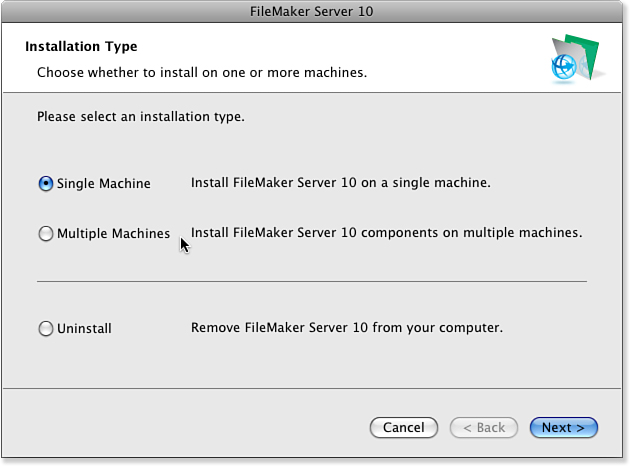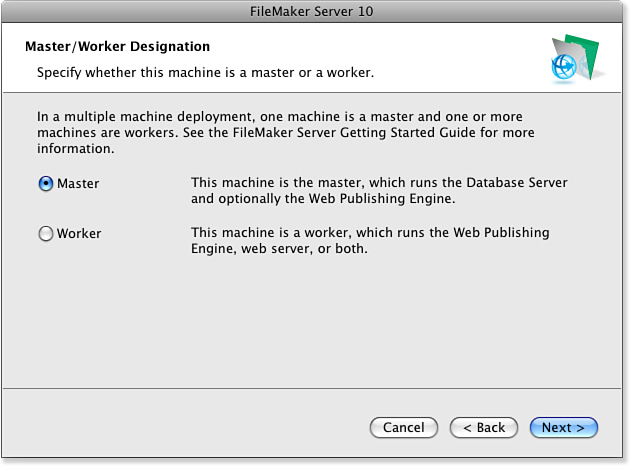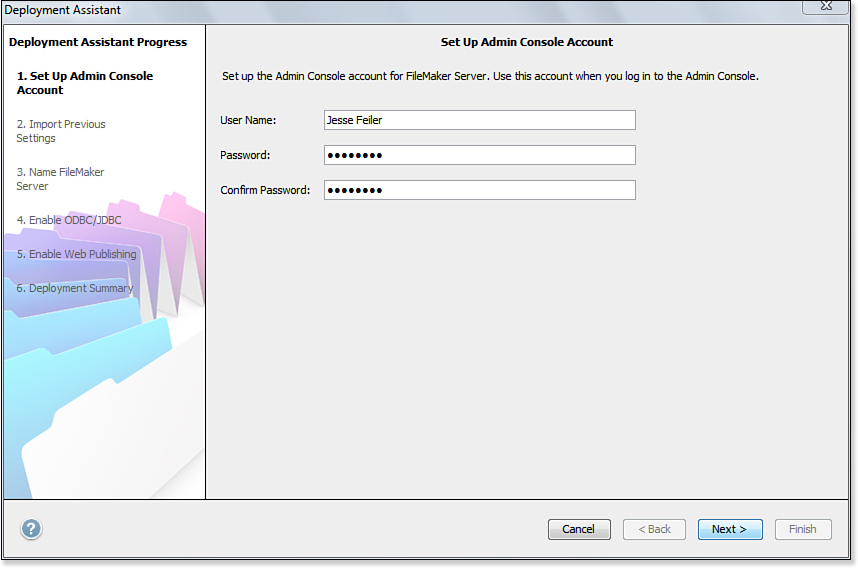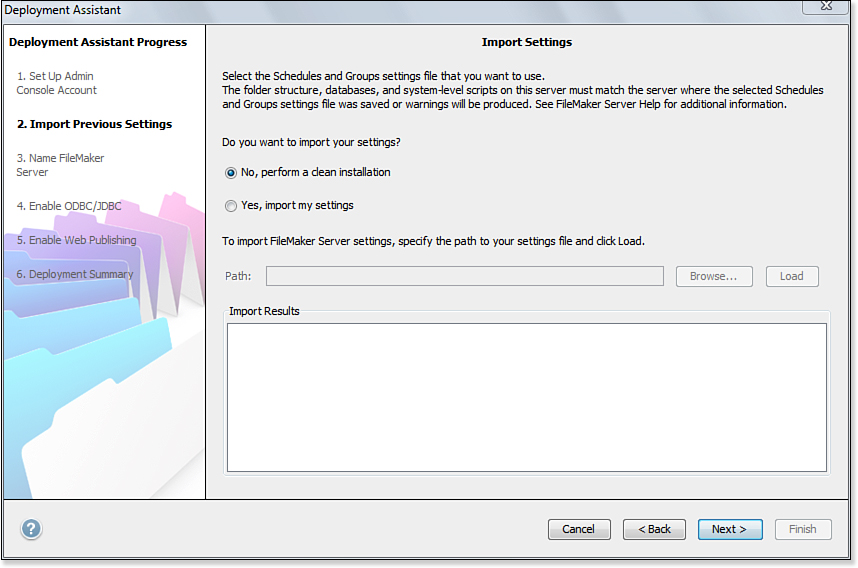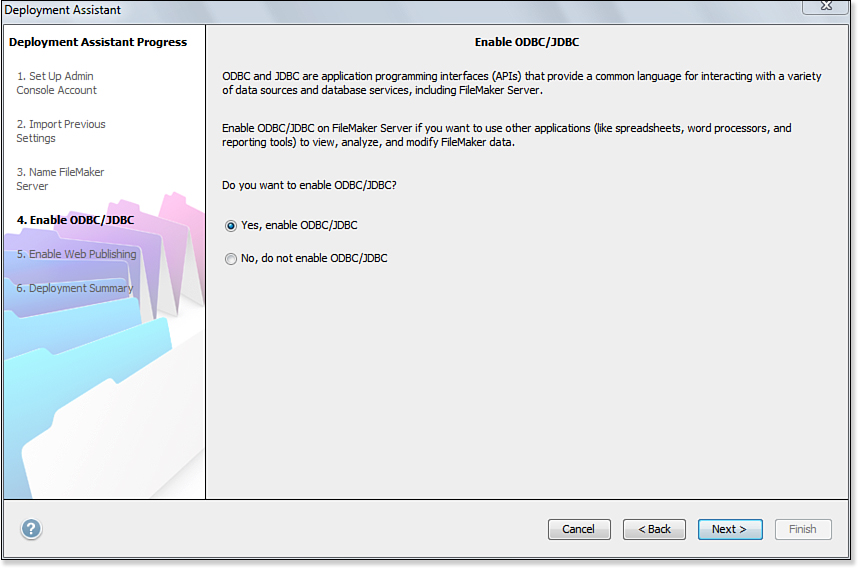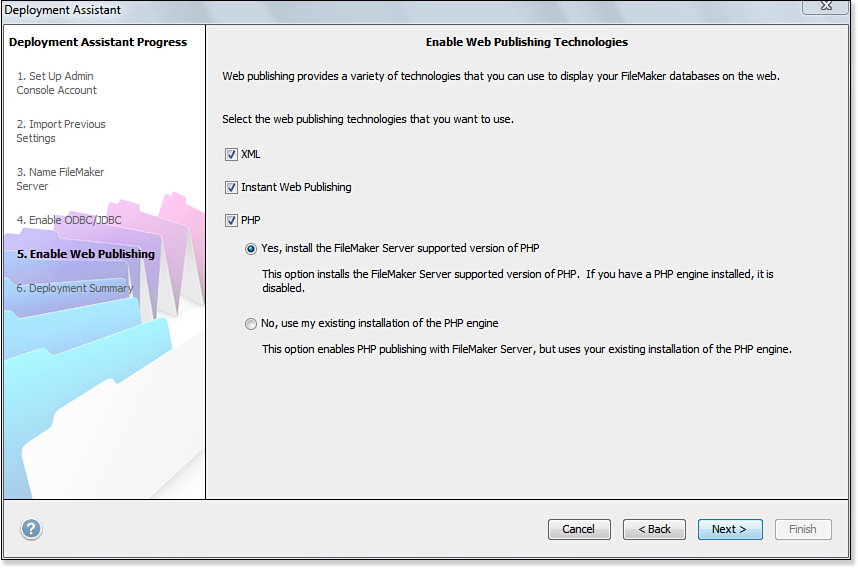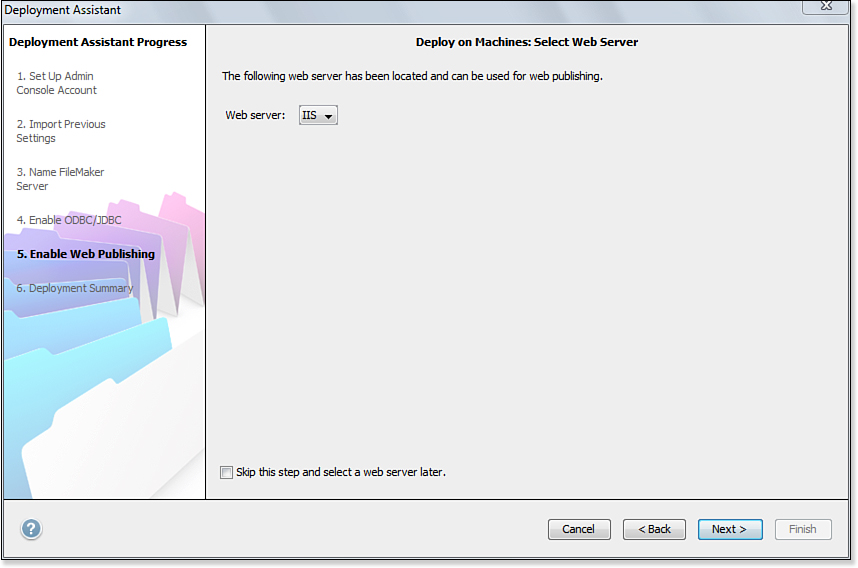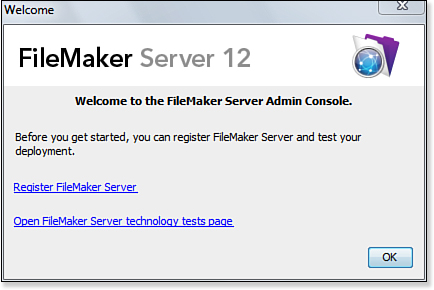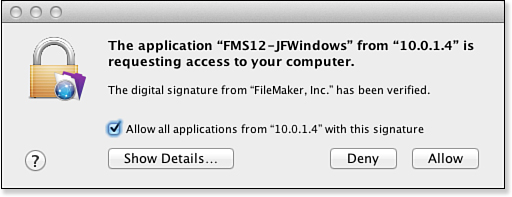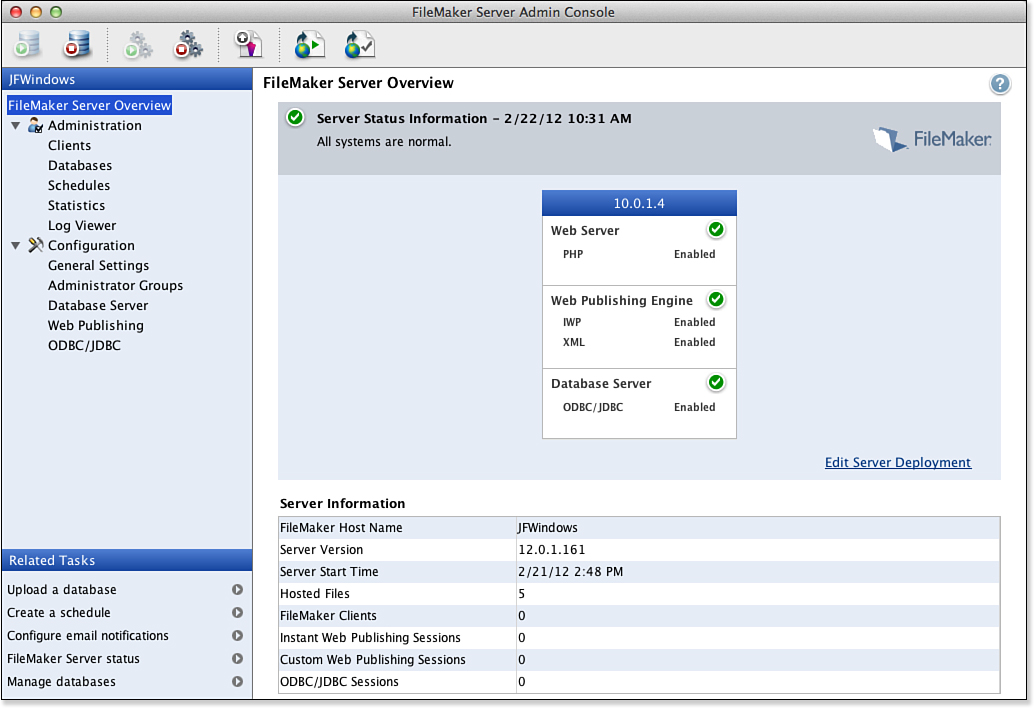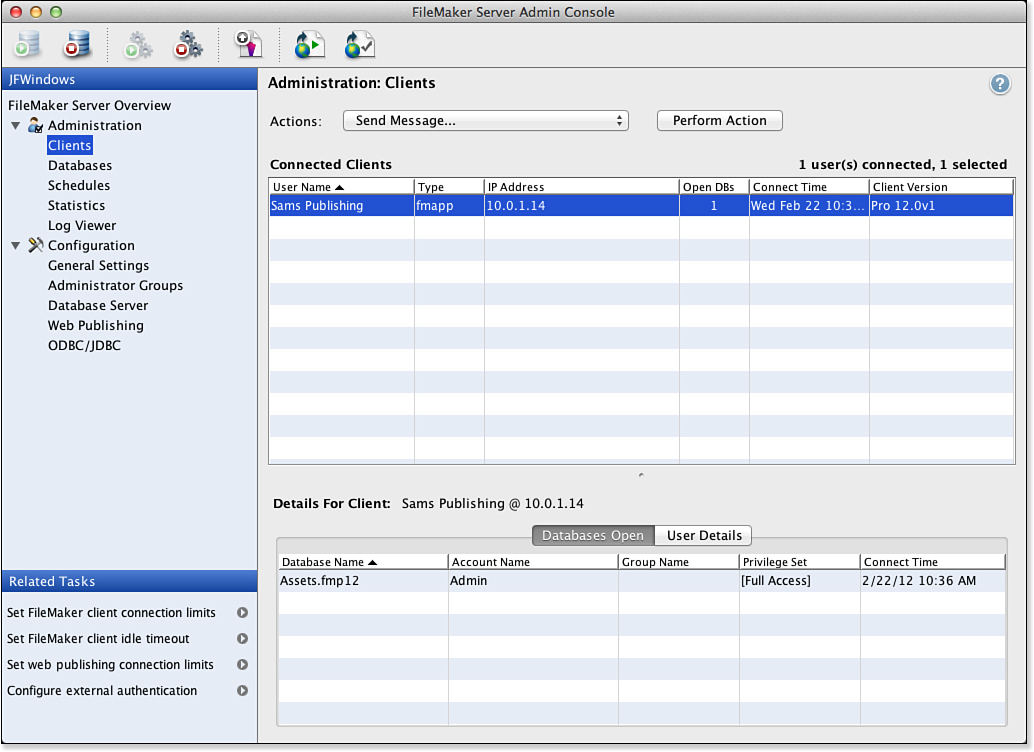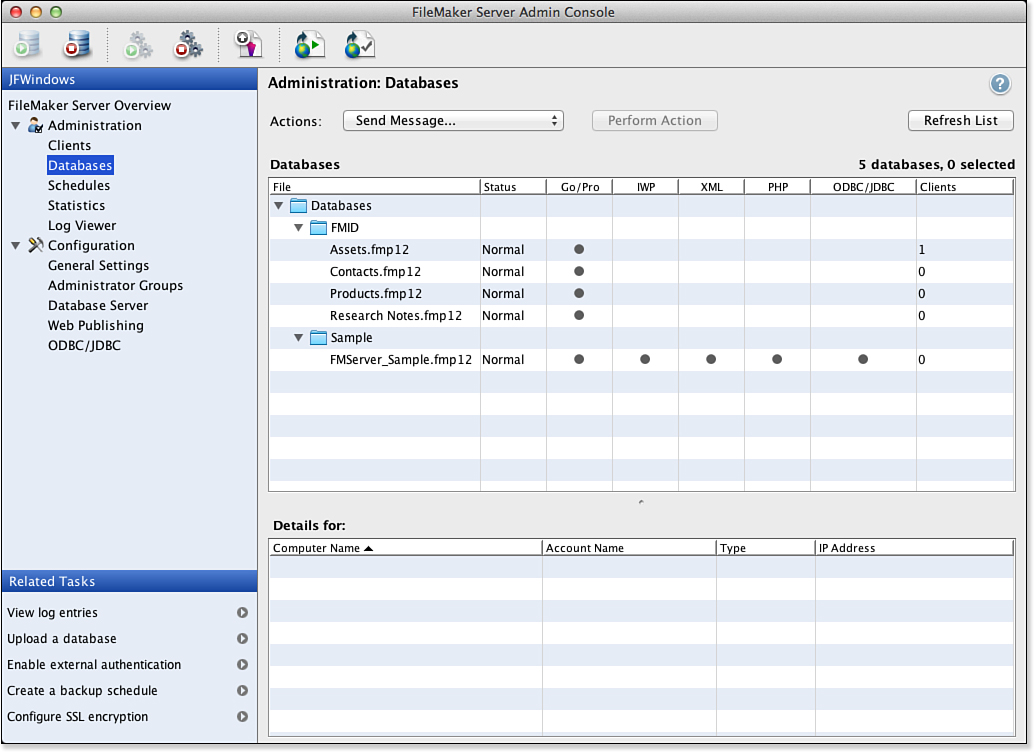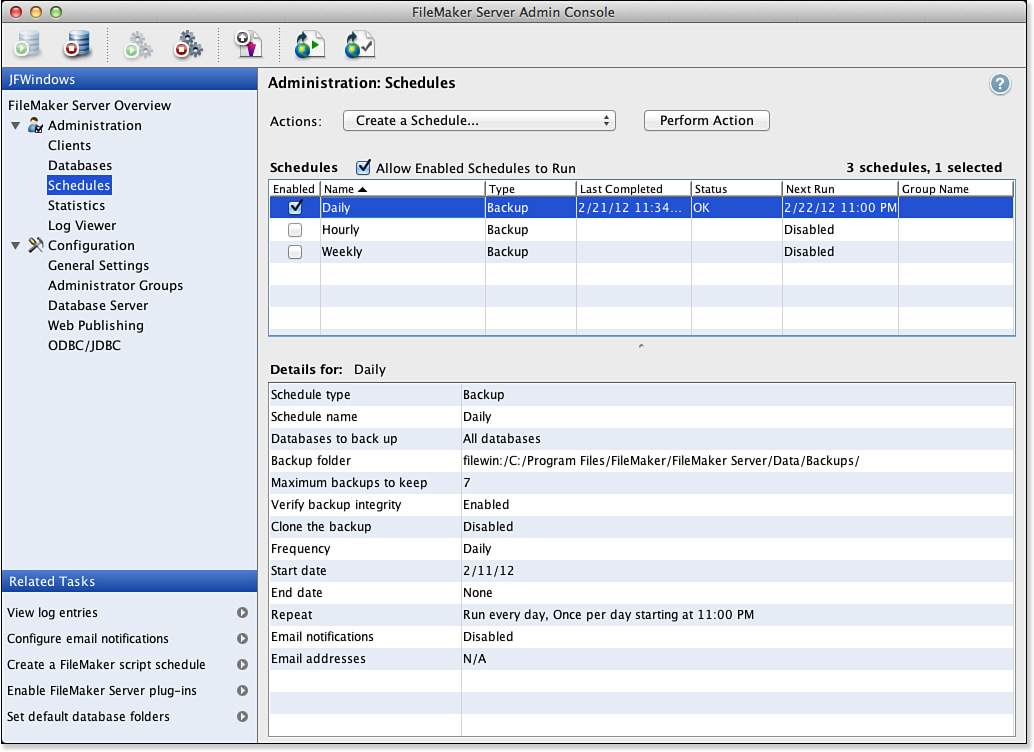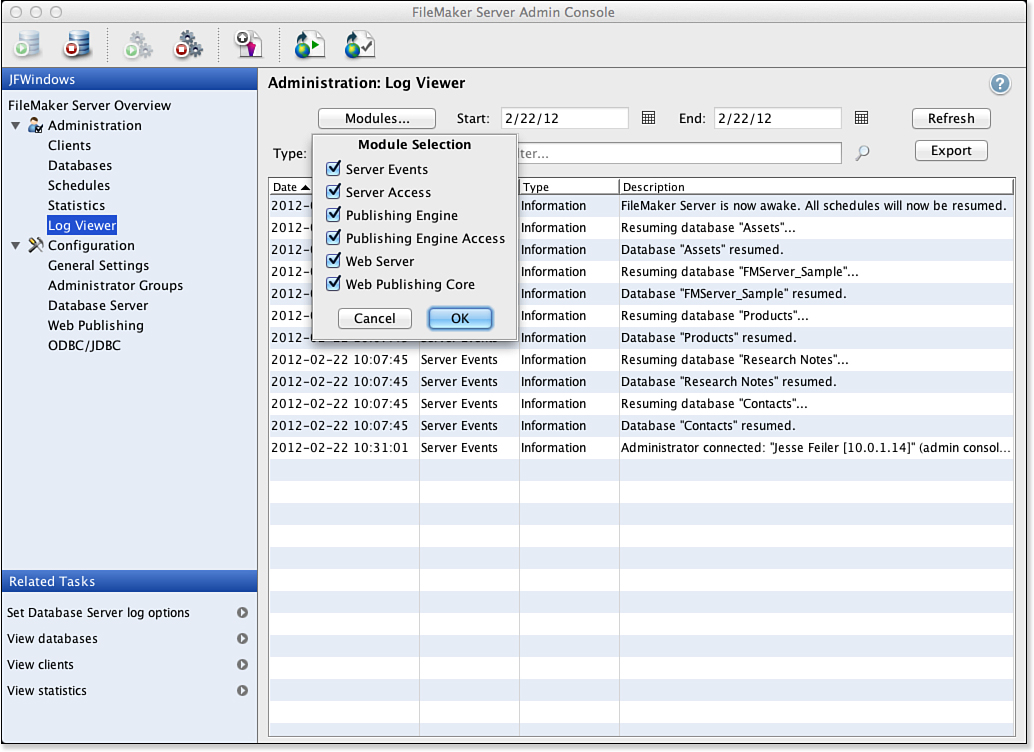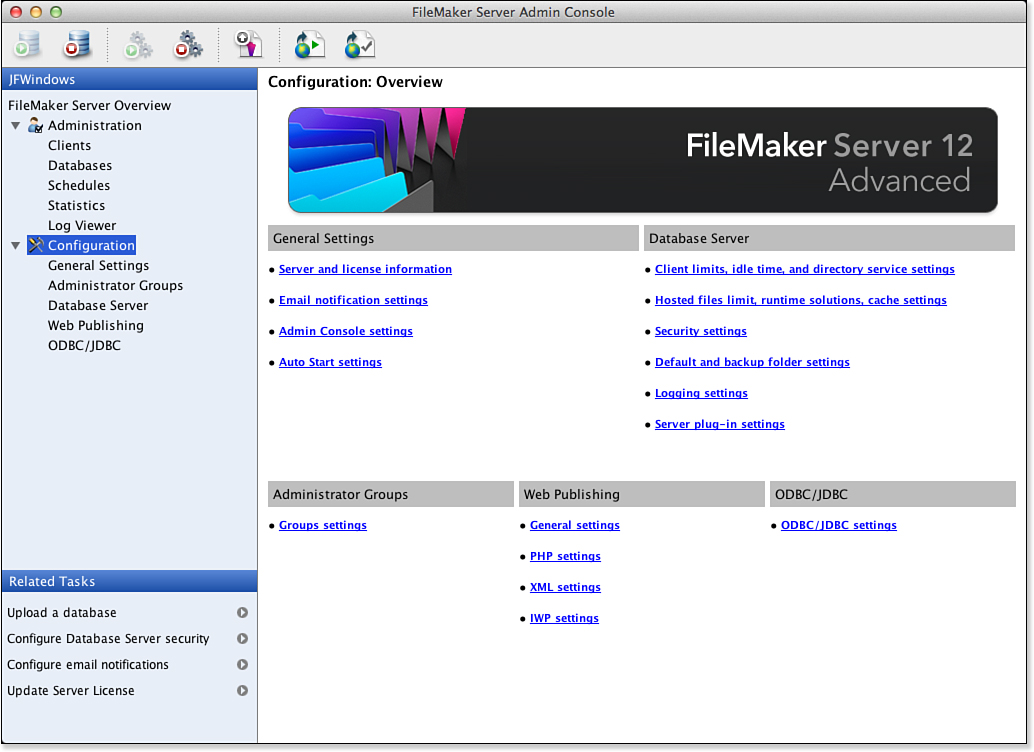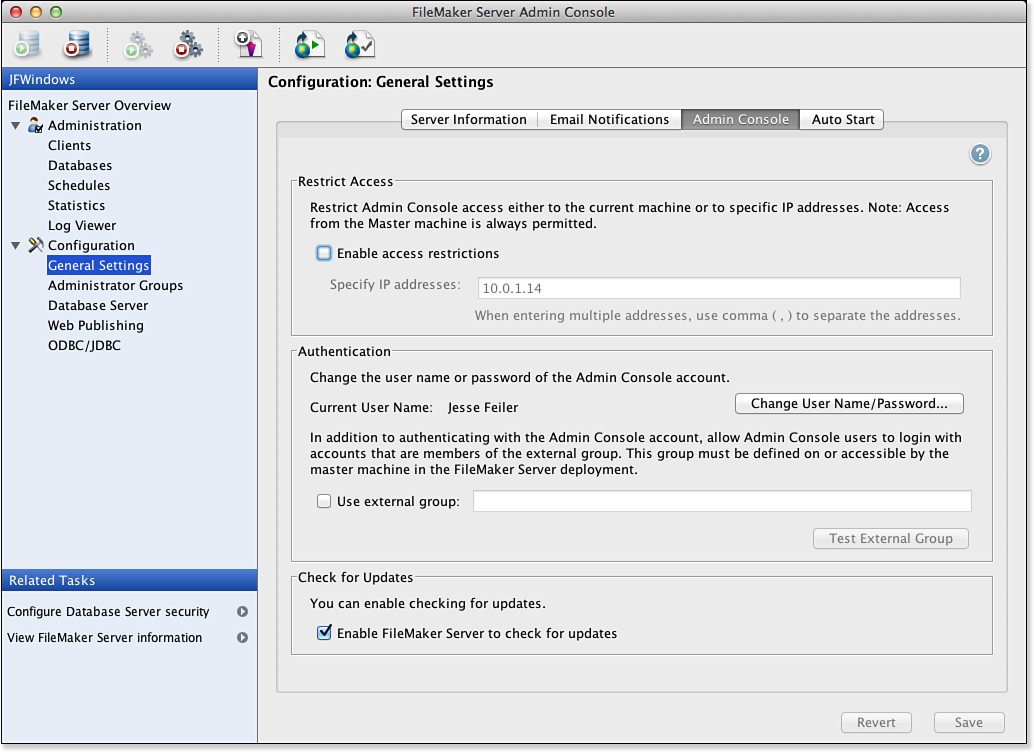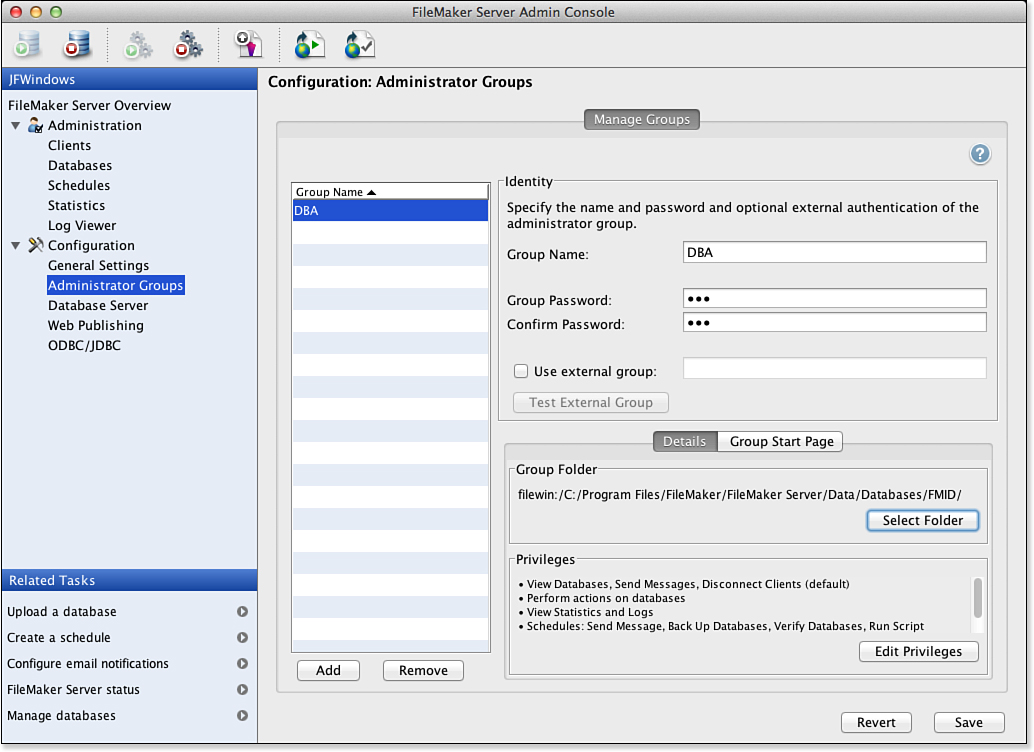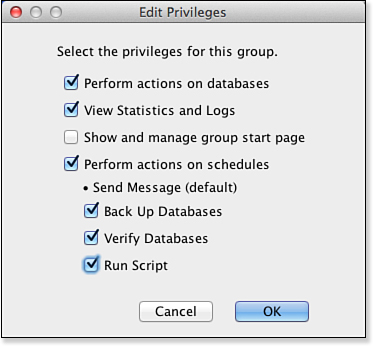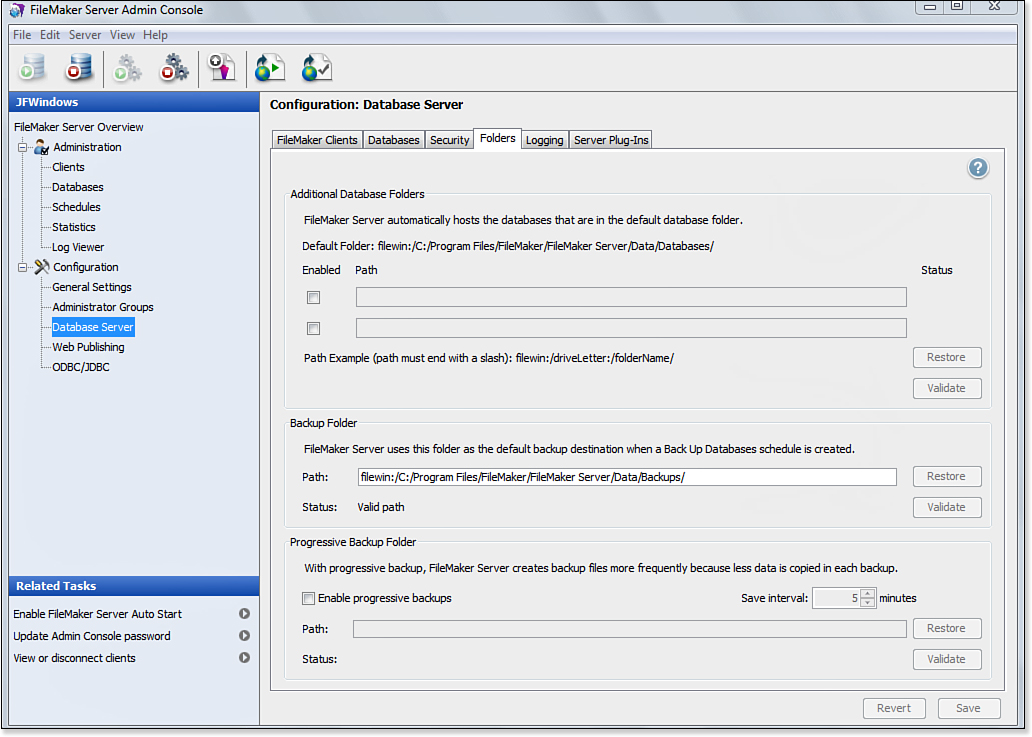27. FileMaker Server and Server Advanced
About FileMaker Server
You use FileMaker Server to make your FileMaker Pro databases available to many users at once across a network. On its own, the FileMaker Pro software can host files for networked access from up to ten users at a time, in what’s called a peer-to-peer configuration. The stability, security, and management features of FileMaker Server make it a preferred solution even for many environments that could manage with peer-to-peer solutions. However, small shops (particularly those with part-time FileMaker use) can function quite effectively with peer-to-peer configurations. As you learn in this chapter, the actual sharing is accomplished by one user running FileMaker Pro and allowing up to nine other users to connect to it, for a grand total of ten users.
That configuration handles the needs of many small businesses. Because it is ten users at a time, many small businesses with as many as a dozen regular users of FileMaker Pro can manage with the restriction; small businesses with much larger staffs, not all of whom use FileMaker, can also handle this restriction. Using FileMaker Pro allows you to use Instant Web Publishing for up to five users.
However, for larger environments, serious web publishing, or environments where automated management of databases and backups are needed, FileMaker Server is what you need.
No discussion of FileMaker Server would be complete without mentioning Apple’s iOS devices (iPad, iPhone, and iPod touch) along with FileMaker Go, which runs on all of those devices. FileMaker Pro or FileMaker Pro Advanced is the tool you use to create sharable FileMaker databases. As you have seen in Chapter 4, “Working with Layouts,” and Chapter 14, “Advanced Interface Techniques,” FileMaker Pro now provides extensive support for mobile devices. Many of the Starter Solutions come with alternate layouts for desktop and mobile devices
The FileMaker Server Product Line
Two products are available under the name FileMaker Server:
• FileMaker Server—FileMaker Server is used to provide concurrent access to as many as 250 networked users running FileMaker Pro client software; it also provides Custom Web Publishing (but not Instant Web Publishing) for 200 users.
• FileMaker Server Advanced—This product supports an unlimited number of FileMaker Pro clients (in practice, the limit is determined by the hardware configuration). In addition, it supports up to 200 XML or PHP web publishing clients, along with up to 100 Instant Web Publishing clients and ODBC/JDBC clients.
![]() For a discussion on ODBC and JDBC, see Chapter 23, “Exporting Data from FileMaker.”
For a discussion on ODBC and JDBC, see Chapter 23, “Exporting Data from FileMaker.”
![]() To find out about Instant Web Publishing, see Chapter 24, “Instant Web Publishing.”
To find out about Instant Web Publishing, see Chapter 24, “Instant Web Publishing.”
![]() Custom Web Publishing is discussed in Chapter 25, “Custom Web Publishing with PHP and XML.”
Custom Web Publishing is discussed in Chapter 25, “Custom Web Publishing with PHP and XML.”
To upgrade from FileMaker Server to FileMaker Server Advanced, you must purchase a new license key that unlocks the FileMaker Server Advanced functionality; there is no installation to be done.
FileMaker Server Versus Peer-to-Peer Database Hosting
With peer-to-peer sharing, FileMaker database files may be served to no more than nine clients at a time. The peer-to-peer method uses a regular copy of FileMaker Pro or FileMaker Pro Advanced as the database host, so a deployment of this type also forgoes important features of FileMaker Server, especially the capability to make regular, scheduled backups of the databases. Although such schedules could be created with operating system–level scripting technologies, it’s much simpler to use FileMaker Server’s built-in tools.
If you choose to begin with a peer-to-peer configuration for database sharing, we recommend that you still treat this situation as a server-type deployment as far as possible. Give the database host its own dedicated machine on which to run—one that people won’t casually use for other daily tasks; make sure that you have a reliable solution for regular backups. Make sure that the machine at least meets the minimum specifications for the FileMaker Pro client software and add a bit more RAM if you possibly can.
It is common to begin with peer-to-peer networking and then to move on to a FileMaker Server installation. The host computer’s software will change, but all the users of the database will connect in the same way: by choosing the Open Remote command. They might have to select a different computer from the list of local hosts, but the new server can be added to the favorites list. Users do not normally know whether they are connecting to FileMaker Pro in a peer-to-peer environment or to FileMaker Server.
FileMaker Server Capabilities
We’ve talked about some of the features that set the FileMaker Server product line apart as a hosting solution: much greater scalability than the plain FileMaker Pro software and the capability to perform automated tasks such as backups. There are quite a number of other distinguishing features as well. Here are some of the most important:
• Admin Console—FileMaker Server comes with Admin Console, a Java application that can be used to administer one or several instances of FileMaker Server, potentially all running on different machines. A separate copy of Admin Console is created for each FileMaker Server instance to be managed. Subject to security constraints, Admin Console can run on any computer that can connect to the server computer over a network.
• Consistency Checker—FileMaker Server performs consistency checking on files as it opens them. If the check fails, a message will be written to the application log and the file will not open.
• Scheduling—You can create schedules to run automatically to back up or verify databases, send messages, or run scripts.
• Server-side scripting—FileMaker Server can run FileMaker scripts as well as operating system scripts. You can schedule these within FileMaker Server. A particularly common use of these is to periodically run an export script that puts files into a known location (perhaps using Get (DocumentsPath) ) where they can be retrieved by other applications.
• SMTP email—FileMaker Server can send email on its own directly from an SMTP server rather than through a mail client that in turn accesses the SMTP server.
• Email notifications—You can configure FileMaker Server to provide email notifications of conditions and status to one or more email addresses. Thus, instead of having to check the server status, the server status will come to you.
• External authentication—FileMaker Server can be configured to check user credentials against a networked authentication source, such as a Windows Active Directory server or an OS X Open Directory server.
• Secure transfer of data—When FileMaker Pro clients are used in conjunction with FileMaker Server, the transfer of data can be encrypted with Secure Sockets Layer (SSL).
In addition to these features, FileMaker Server offers a large number of other important functions, such as the capability to send messages to guests, to disconnect idle guests, to limit the visibility of database files based on user privileges, to be run in a scripted fashion from the command line, and to capture a variety of usage statistics and server event information for logging and analysis. All these features are discussed in the sections to come.
FileMaker Server Requirements
Like any piece of server software, FileMaker Server has certain minimum hardware and software requirements. You’ll achieve the best results with a dedicated server; as with any piece of server software, it’s best if FileMaker Server is the only significant server process running on a given machine. Forcing FileMaker Server to compete with other significant processes, such as mail services or domain controller services, is likely to hurt Server’s performance.
The server machine, in addition to being dedicated as far as possible to FileMaker Server, and having the minimum amount of file sharing enabled (preferably none), also needs the items discussed in the following sections.
Web Server
FileMaker Server requires a web server. On Windows, this is IIS; on OS X, it is Apache. You might have to install and configure IIS before beginning the FileMaker Server installation process. On OS X, Apache is part of the standard installation; you might have to start it if you have not enabled it before. And if it has been removed, of course, you will need to reinstall it.
The web server will need PHP; you can use a version of PHP on your own web server, or you can have it installed as part of the FileMaker Server installation process (it does not require any extra discs or licenses).
Static IP Addresses
Clients must be able to connect to the server computer. It must either have a static IP address or a domain name that is set to a static IP address. If you are running a local area network, it is quite possible that a single Internet connection to your router is shared among all the computers. The router will have an IP address visible from the outside. This might or might not be static. In the case of cable connections, it is frequently renewed once a day with the same or a different address.
FileMaker Server is capable of multihoming, meaning that it can take full advantage of multiple physical network interfaces, each with its own IP address. FileMaker Server listens on all available network interfaces. As far as we know, it’s not possible to configure FileMaker Server to ignore one or more of the available interfaces; if the interface is available, FileMaker Server tries to bind to port 5003 on that interface and begins listening for FileMaker traffic. The FileMaker client/server port number, 5003, is also not configurable.
The computers on the local network share that one changing IP address, but they might have a static IP address beginning with 192.168 or 10.0. This is determined by the configuration of the network server. It is under your control, not the control of your ISP. If the only access to your server computer is internal, you can provide it with a static internal IP address. However, if it has to be accessed from the outside, you must work with your ISP to provide it with a static IP address that, like all IP addresses on the Internet, must be unique.
Fast Hard Drive
Like any database, FileMaker Server is capable of being extremely disk-intensive. For some database operations, particularly those involving access to many records—such as a large update or a report—the speed of the server’s hard disk might be the limiting factor. Redundant Array of Inexpensive Disks (RAID) technologies (whereby multiple physical disks are combined into a single disk array, for greater speed, greater recoverability, or both) are becoming ever cheaper, and some sort of RAID array might well be the right answer for you. When it comes to FileMaker Server performance, buy the biggest, fastest disk you can.
At the time of this writing, a RAID system with two 1TB drives providing RAID 0 support of 2TB or RAID 1 support (redundancy) of 1TB can be purchased for less than $500.
Fast Processors
A fast processor is a fairly obvious requirement for a server machine. But it’s worth noting that FileMaker Server can take full advantage of multiple processors.
Lots of RAM
Beginning with FileMaker Server 12, the Database Server and Web Publishing Engine are now 64-bit processes that can use much more RAM than their predecessors. There is a single installer for OS X that contains both 32- and 64-bit software; on Windows there are two installers.
Turn Off Unnecessary Software
You do not want the computer running FileMaker Server to sleep, hibernate, or go into standby mode. A screensaver is also unnecessary—most of the time, your server computer will not even need a monitor, and the simplest screensaver of all—turning off the monitor’s power switch—is the best.
Indexing Service (Windows) and Spotlight (OS X) are great tools to help you find information on your computer, but they use resources in the background—both processor power and disks, both of which are needed for FileMaker Server. If the computer running FileMaker Server does not need Indexing Service or Spotlight, turn off those options. These settings apply to all types of servers.
You also should disable antivirus software on the folder where the database files are stored (but only that folder).
Fast Network Connection
FileMaker is a client/server application, which means that FileMaker Pro clients remain in constant contact with a database host such as FileMaker Server. FileMaker Server constantly polls (attempts to contact) any connected clients to determine what they’re doing and whether they’re still connected. In addition, although Server is capable of handling a few more tasks than its predecessors, it still has to send quite a lot of data to the client for processing in certain kinds of operations. All this means that FileMaker is an extremely network-intensive platform that benefits greatly from increased network speed. A switched gigabit Ethernet network will provide good results.
Supported Operating Systems
FileMaker Server runs on OS X and Windows.
![]() For the latest OS X and Windows version information, see www.filemaker.com.
For the latest OS X and Windows version information, see www.filemaker.com.
Java Runtime Environment
You must have the Java Runtime Environment installed. If you do not have it installed, you will be prompted to allow it to be automatically installed. You do not need any extra discs.
Data Center Environment
Although not strictly a requirement for running FileMaker Server, proper care and housing of server equipment is a necessity, one that’s often overlooked, especially in the small- and medium-sized business sectors, some areas of education, and among nonprofit groups. These are all key groups of FileMaker users, ones that do not always have sufficient resources to build and maintain anything like a data center.
Ideally, a server of any kind should be housed in a physically secure and isolated area, with appropriate cooling and ventilation, with technical staff on hand 24 hours a day to troubleshoot any issues that arise, and with automated monitoring software that periodically checks key functions on the server and notifies technical personnel by email if any services are interrupted. Some organizations are fortunate enough to be able to house their FileMaker servers in such an environment. But even if you can’t provide all those amenities, you can see to the key areas. The server should minimally be up off the floor, well ventilated, and under lock and key if possible. And some sort of monitoring software is nice, and need not break the bank: Nagios (www.nagios.org) is a popular and powerful open source monitoring package.
Nagios runs on UNIX but can monitor servers running on almost any platform. Many server monitoring packages exist for Windows deployment as well.
External Data Centers
A number of companies provide FileMaker hosting. Search the FileMaker website for “FileMaker hosting” to see a list. You can use a shared copy of FileMaker Server running at a remote site to run your databases and support your web publishing. The vendor will provide you with the tools to upload your databases and open them. Users will connect using your domain name or the IP address of the FileMaker host. You do not have to purchase FileMaker Server because your monthly payment reimburses the hosting company for its purchase of the software. Your monthly payment also covers its data center environment, backups, and monitoring.
Installing and Deploying FileMaker Server
The process of installing and deploying FileMaker Server is different from installing software such as a word processing application or even FileMaker Pro. FileMaker Server runs in the background and has no user interface; you interact with it using Admin Console, a Java application that runs on the server computer or any other computer that has network access to the server computer.
Step 1 in the installation process is to uninstall any previous version of FileMaker Server. The easiest way to do this is to use the original distribution discs or disk images from which you did the installation. Follow the instructions in the Getting Started guide and through the links it contains to the FileMaker website. You will need to stop FileMaker Server itself and the Web Publishing Engine (if installed and running), run the uninstall process, and restart the server computer. If the server computer is running a previous version of FileMaker Server or any other applications, you should know that a restart might be required as part of the uninstall process. Unless you are starting an install on a computer that is currently not running any networked applications, you are probably going to find yourself doing this at night, on a weekend, or on a holiday. Doing this when the production environment can be stopped is helpful. It might take only you an hour to install, deploy, and configure FileMaker Server, but that hour will go much faster if users are not poking their heads into the room or sending you text messages asking, “How much longer?”
The Installation Process
On Windows, all files are installed in a directory called Program FilesFileMakerFileMaker Server. On the OS X, the FileMaker Server components are installed in /Library/FileMaker Server. The default install location can be changed on Windows, but not on the OS X.
Installation is handled by an automated process. All that you have to do is to enter your name and license code. Note that the license code company name must exactly match the name on the license you have received from FileMaker. If there are any misspellings or mistakes in the name, you must either correct them with FileMaker or grit your teeth and enter them in their incorrect version during the install process.
After FileMaker Server is installed and deployed, you can manage it using Admin Console on any computer that has network access to the FileMaker Server computer. For the initial installation and deployment, however, you need hands-on access to the FileMaker Server computer. If it normally runs without a keyboard and monitor, attach them before beginning the process. When everything is complete, you can turn off the monitor or even detach it.
FileMaker Server Configurations
FileMaker Server can run in several configurations. There are three components to deal with:
• Database server—This is the FileMaker database engine. It controls access to the databases. In FileMaker Server terminology, whatever computer is running the database server is the master computer. All others (if any) are worker computers.
• Web Publishing Engine—This is the FileMaker software that enables Custom Web Publishing and Instant Web Publishing. Instant Web Publishing is available only for FileMaker Server Advanced, but Custom Web Publishing is available in both products.
• Web server—This is IIS (Windows) or Apache (OS X). The web server should be configured and set up before you begin the FileMaker Server installation, but you can come back later to complete the configuration if you want. It is the Web Server module that lets the Web Publishing Engine talk to the web server. Also, as part of the FileMaker Server installation process, PHP might be installed. If it is already installed on your web server, you can use that version as long as it meets the compatibility requirements for your version of FileMaker Server.
You can install these components on one, two, or three computers. Because the computers communicate using standard protocols, it does not matter which operating system is used on which computer in a multicomputer environment. Here are the configurations you can use:
• Single computer—The database server and the Web Publishing Engine on a single computer along with your web server. This is obviously the simplest installation, and it might be the best one to start with. Certainly, if you are creating a test environment to explore FileMaker Server, it is a logical place to start. This configuration is recommended for no more than 50 FileMaker Pro clients.
• Two computers: web/database—With two computers, you can put all the web components on one computer, leaving the database server alone on the other computer. This is generally the highest performing configuration.
• Two computers: FileMaker/web server—Another configuration places the main FileMaker components (Web Publishing Engine and database server) together on one computer. The only software that must be installed on the web server is the Web Server module. This configuration might be advisable or even required where the web server is used to provide other services in addition to FileMaker.
• Three computers—Each of the components is on its own computer. This is suitable for very heavy loads because the web server does not have to compete for resources with anything else. Tuning the web server’s performance might be easier in this environment. Note that because there is intercomputer communication between the web server and the Web Publishing Engine, this configuration can in some cases provide slightly poorer performance than a two-machine configuration.
Except in the very unusual situation in which everything is installed on a single computer and the only clients accessing FileMaker Server are on that same computer (an environment usable only for testing), there has to be communications among computers managing FileMaker Server, Admin Console, the FileMaker Pro clients, and the clients of the web server. These communications should be protected by firewalls on the various computers. Table 27.1 provides a list of the ports, their purposes, and which computers need access to them.
Table 27.1. FileMaker Server Firewall Ports
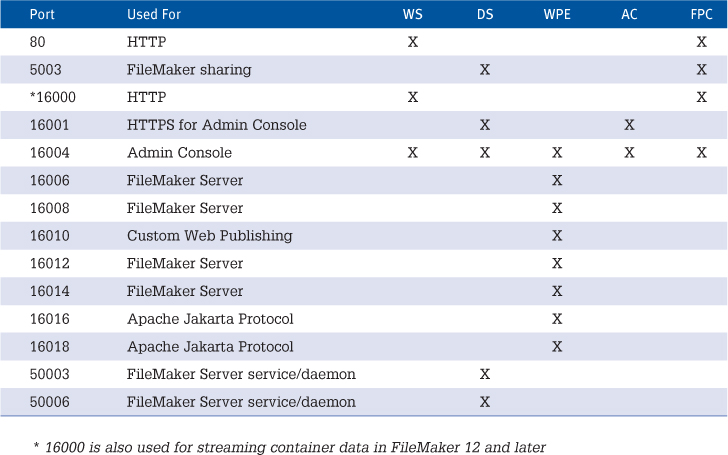
Firewalls
Whenever you are dealing with a network connection, you are usually dealing with firewalls and ports (if you are not, you are running a major security risk). Table 27.1 provides the official FileMaker Server port list. If you open these ports before you install FileMaker Server, things will go faster. The users of the ports are the Web Server (WS), Database Server (DS), Web Publishing Engine (WPE), Admin Console (AC), and FileMaker Pro clients (FPC).
Selecting the Configuration
When you begin the installation process, the installer will present the window shown in Figure 27.1 to begin configuration. Choose whether this will be a single-machine or multiple-machine installation.
Figure 27.1. Choose a single- or multiple-machine configuration.
If you choose a multiple-machine configuration, you will need to install FileMaker Server on each computer. The window shown in Figure 27.2 lets you specify for each computer whether it is a master computer (with the FileMaker Database Server installed on it) or a worker.
Figure 27.2. For multiple-machine configurations, install FileMaker Server on each computer.
Along the way, you might be asked to confirm various steps in the process, such as accepting a security certificate. These are all normal parts of any installation. With regard to security, the dialogs you see should identify FileMaker as the origin of the software, and if that is the case, you are okay to continue.
The Deployment Process
After you have completed the basic installation process, you will be prompted to continue on to the Deployment assistant. If you elect not to do so, pick up at this point by choosing Start, Programs, FileMaker Server, FMS 12 Start Page (Windows) or by double-clicking the FMS 12 Start Page shortcut that was installed on the desktop. The FileMaker Server Admin Console start page shown in Figure 27.3 will appear. It gives you an opportunity to manually start Admin Server if it has not started automatically.
Figure 27.3. Admin Console start page.
In part because the Deployment assistant and Admin Console are Java applications and you might not have run Java applications on your computer before, a little fiddling could be required to get them to run. You can find troubleshooting tips at the end of this chapter, and the Getting Started guide that is installed as part of the FileMaker Server documentation is an invaluable resource. You can find additional information on the FileMaker TechNet site. After the installation and deployment process is done, you should not have to worry about these issues again.
The Admin Console Start Page will appear. It gives you an opportunity to manually start Admin Server if it has not started automatically.
Along the way, you might see messages asking you if you want to allow access to specific resources such as the Java application. If you are confronted by messages such as these, remember that you have started a process of installation and deployment of a FileMaker product, so a message asking if FileMaker is a legitimate provider of software should be answered Yes or Always. If you launch an installation of FileMaker and see a message asking you to approve installation of software from another vendor, you might get suspicious—although Java, which is not a FileMaker product, is installed. If you get a warning of software from some other vendor or a name you do not recognize, you might want to contact FileMaker customer support.
There are five or six steps, depending on whether you are doing a single-machine configuration. All of these settings can be changed later.
• Set up the Admin Console account with an ID and password as shown in Figure 27.4. If several people are administering the installation, they can share this account. You also will be able to set up groups of administrators with their own security settings. Groups are available only with FileMaker Server Advanced.
Figure 27.4. Set up the Admin Console account.
• You have the option to import settings from a previous installation, as shown in Figure 27.5.
Figure 27.5. You can import settings.
• Name this particular FileMaker Server installation, providing a brief description and the name and contact information for the person responsible, as shown in Figure 27.6.
Figure 27.6. Name the FileMaker Server.
• You can enable ODBC/JDBC publishing if you are using FileMaker Server Advanced, as shown in Figure 27.7. You do not need to enable ODBC/JDBC publishing to access ODBC/JDBC data published elsewhere that you and your users want to consume. This interface is simple: Click Yes or No.
Figure 27.7. Enable ODBC/JDBC if you want.
• You are asked whether you want to enable web publishing. If you agree, choose which web publishing technologies you want to use (XML, Instant Web Publishing [IWP requires FileMaker Server Advanced], and PHP), as shown in Figure 27.8.
Figure 27.8. Choose your web publishing technologies.
• You can then choose your web server (or choose to select it later), as shown in Figure 27.9.
Figure 27.9. Select your web server.
• You can choose which of the configurations you want to install, as shown in Figure 27.10. The deployment type is set in the pop-up menu at the top of the window.
Figure 27.10. Choose your configuration.
• A final summary screen reviews your choices, as shown in Figure 27.11. You can use the Back button to go back and change them. You also can rerun Admin Console at another time and change many of them. (Note that the initial installation of the software for the master and worker computers, as well as the deployment type shown previously in Figure 27.10, cannot be changed later.)
Figure 27.11. Review the installation summary.
If the web server is not running (perhaps it is installed but not running), you cannot complete this step and will have to come back to it.
You will be provided with information about the progress of the deployment. When it is complete, you will be invited to register (a good idea) and to run the technology tests (a critical step), as shown in Figure 27.12
Figure 27.12. Run the tests.
At this point, FileMaker Server is installed and deployed. You can use the Admin Console on any computer with network access to the FileMaker Server computer to administer it from now on.
If you will not be using a monitor or keyboard on the FileMaker Server computer, it is a good idea to take two additional steps before removing them. First, verify that any automated power equipment is working properly to avoid interruptions. In the case of an extended outage, the uninterruptible power supply (UPS) should shut down the server computers gracefully. Make certain that you can power them back on again successfully and that the databases open properly. If there are any problems, check them out before disconnecting the monitor and keyboard. Likewise, make certain that you can access the computer using Admin Console from another computer before disconnecting the monitor and keyboard.
Running FileMaker Server
Installing FileMaker Server installs two separate components, both of which run as services: FileMaker Server and the FileMaker Server Helper. They appear as two separate services (Windows) or processes (OS X). FileMaker Server does not function correctly without the FileMaker Server Helper service also running. Installing FileMaker Server Advanced will cause additional services to be added.
Starting and Stopping FileMaker Server
When you install FileMaker Server, you can choose whether to have these services start automatically, in which case they are started every time the server computer itself starts up, or manually, in which case you need to start the services by hand. The Admin Console lets you start and stop FileMaker Server manually.
Hosting Databases
When FileMaker Server starts, it looks for files in the default database file directory, and in the alternate database directory if one has been specified. (We discuss how to specify the alternate directory later.) It also tries to open any databases found in the first directory level within either of those two top-level directories. Databases in more deeply nested directories are not opened. You can find the main database directory at c: Program Files FileMaker FileMaker Server Data Databases (Windows) and /Library/FileMaker Server/Data/Databases (OS X).
Take care to place these directories on hard drives that are local to the server machine. It’s not at all a good idea to host files from a mapped or networked drive. In such a configuration, every database access has to be translated into a network call and passed across the network. At the very least, this approach is likely to cause significant loss of performance.
In the world of databases, it is common to speak of starting and stopping databases, which is basically the same as opening and closing them. FileMaker Server often uses the open/close verbs, but if you are working with people from other environments, make certain you are all clear about what is meant by “stopping a database”—in other words, do you mean closing the database and leaving FileMaker Server running, or closing FileMaker Server and all its databases?
Using Admin Console
When you first install FileMaker Server, you might be prompted to install and open AdminConsole. You have a variety of choices about when to do this, and you will have prompts and options to place shortcuts on the desktop. At that time or thereafter, you can open Admin Console manually. To do so, open a browser on any computer with network access to the computer where FileMaker Server is running (even the same computer). Enter the IP address of that computer and port number 16000. Here are three formats for that URL:
http://localhost:16000
http://10.0.1.2:16000
http://www.mydomain.com/rex:16000
The first is used if you are running the browser on the same computer as FileMaker Server. The second is used to address the server computer by its IP address (either locally or over the Internet). The third is used if you have a domain name and have configured a name for the computer running FileMaker Server. In all cases, you use port number 16000.
FileMaker Server responds by sending a small Java application to your computer. You will be asked to log in, and the database will open. You also might be asked for permission to run it, as you see in Figure 27.13.
Figure 27.13. Give permission to Admin Console.
If you look carefully at Figure 27.13, you will see that FileMaker Server is running on a Windows computer but Admin Console is running on OS X. This (along with the reverse) is a common configuration.
FileMaker Server Overview
Figure 27.14 shows FileMaker Server Overview in Admin Console. It is the default screen, and you can always return to it by clicking FileMaker Server Overview at the left.
Figure 27.14. FileMaker Server Overview summarizes the status and settings.
All the windows in Admin Console have a similar layout. The navigation pane at the left lets you view and change settings. The center and right of the window contains detailed information about whatever you are viewing; in the lower left, links let you go to related tasks and documentation. At the top of the window, in the toolbar, are seven icons:
• The first two let you start and stop the database engine (not an individual database).
• The third and fourth let you start and stop the Web Publishing Engine (if it is installed).
• The fifth starts the Upload Database assistant.
• The sixth lets you view the FileMaker Server Start page in a browser.
• The seventh opens the test page; you can run any needed tests again.
The status overview at the center right shows what is running on what machine. If you have a two- or three-computer configuration, there will be a slight space between the boxes representing the machines. In Figure 27.14 (a single-computer configuration), the IP address of the single computer is shown. In a multiple-computer configuration, the IP address for each computer is shown.
You should know the IP address of the master computer, but if you do not, write it down the first time you see this display. It is the IP address people will need to connect with Admin Console (remember to add port 16000 to the IP address when you connect with a browser).
FileMaker Server provides the ability to configure and customize your installation, whether it is large or small. If it is small, there are a few settings in Admin Console that you must know about; you can safely ignore the others unless something strange happens. Many people run FileMaker Server for years without changing the default settings. The minimal items to which you need to pay attention are shown in Tips in the following sections.
Minimum: Note the IP address and the status of each of the FileMaker Server components.
Administration
The Administration section lets you manage clients, databases, schedules, and statistics. A summary screen lets you move among them, or you can click each item in the navigation pane at the left.
Clients
You can see the Clients display in Figure 27.15. Select one or more clients and choose an action from the pop-up menu. Click Perform Action to do it. In general, it is not a good idea to disconnect clients; instead, send them a message to log off. However, if remote users do not respond (perhaps because they have gone out to lunch), you might need to disconnect them if you need to stop FileMaker Server.
Figure 27.15. Manage clients.
The action options are
• Send Message (to the selected client)
• Send Message to All Clients
• Disconnect (the selected client)
• Disconnect All Clients
Minimum: Unless your FileMaker Server environment is small and in a confined area, you will probably use the Clients section to send messages to your users.
Databases
The Databases section, shown in Figure 27.16, provides information for databases managed by FileMaker Server, whether or not they are open. A similar interface to that in Clients lets you send actions to the databases.
Figure 27.16. Manage databases.
Dots indicate the features enabled in the databases. Note that these report the status; you set sharing and the other features in the databases themselves (in the Sharing submenu). This display is useful when you have first added a database; you should check that the correct features are enabled.
The action choices are
• Send Message (to the users of the selected database)
• Send Message to All (to the users of all databases)
• Open (the selected database)
• Open All
• Close (the selected database)
• Close All
• Verify (the selected database)
• Verify All
• Pause (the selected database)
• Pause All
• Resume (the selected database)
• Resume All
• Remote (the selected database)
• Upload Database
You use the Databases section to open, close, and pause databases, as well as to send messages to database users without having to identify them on the Clients display. Pausing a database leaves it open, but flushes the cache and prevents reading or writing. It is most frequently used to create a copy of the database while it is technically open but not in the middle of processing. You can also right-click (Windows) or Ctrl-click (OS X) on the database file for a contextual menu. Resume is the command to leave the pause state.
Schedules
FileMaker Server includes a powerful scheduling feature, as shown in Figure 27.17.
Figure 27.17. Schedule events.
There are four types of events you can schedule:
• Backups
• Verifications
• Execution of scripts and batch files
• Messages
You can also enable all individually enabled schedules with the check box at the top of the list. This capability allows you to temporarily turn off all schedules without changing each one’s status. You might want to do this for diagnostic purposes if you are experiencing slowness.
Using the scheduling feature, you can create, duplicate, delete, or edit schedules; you also can select them and execute them manually. Note that you can enable each schedule with the check box to the left of its name.
You will be walked through your choices when you create or edit a schedule. For a backup schedule, those choices are as follows:
• Select a task (backup, database verification, run a script, or send a message).
• Select from several predefined schedules (daily, weekly, and so forth).
• Select the databases to back up.
• Select the location to which they will be backed up. You also have a choice to verify the backup. This step takes more time, but it means that the backup copy is correct. If you can schedule backups to run overnight when there are few users of the system, this is a useful option. If you are automatically backing up databases, set your tape backup to back up the files from the backup folder, not the live databases. That way, you can avoid issues with backing up live databases that may temporarily be inconsistent.
• Choose the number of backups to be kept. They will be in a single time-stamped folder at the path you specified in the previous bullet. You also have the option to verify or clone the backups. That provides you with more security but it puts a greater burden on the server. If you can schedule the backups for the middle of the night, this may not be an issue.
• When you choose the predefined schedule, you are given the opportunity to refine or change the schedule, giving it a start and stop date, selecting specific days of the week (such as omitting weekends), and specifying how often each day the schedule should be run. You can also specify the number of backups to keep.
• Name the schedule.
• You can specify an email notification to be sent. If you have asked to verify the backups, the verification status will be shown in the email. Note that you can have several recipients for the email notification. What this can mean is that instead of someone having the task of checking the backup schedule in the morning, all that has to happen is a check of email—not an extra step involving the database.
• The last step is a summary of the schedule. This information is also shown at the bottom of the Schedules window shown previously in Figure 27.17.
Set up a backup schedule, ideally at least once a day with an email notification. Back up the databases to a known location, and then, if you have an automated file backup, copy the backup files to another disk, tape, or whatever storage you are using. Make certain that the schedule of the file backup is set for a sufficiently long time after the database backup so that the files are created. For example, schedule the FileMaker database backup for 1 a.m. and the file backup for 5 a.m. Check periodically to see how long the FileMaker backup is taking (the email notification will help). Back up the folder that is created. FileMaker will name it with the backup and the date (Daily_2012_02-21-2334, for example). If you are backing up the backups to tape or some other storage medium, you may simply be able to back up the entire contents of the Backups folder.
FileMaker Server now performs a live backup that requires significantly less time when the databases are unavailable. At the beginning of the backup process, FileMaker Server flushes the cache so that any data saved in memory is written to disk. Then it creates a dirty copy of the file. Users can still access and modify the original file while this copy is being made. After that’s finished, the live database is paused and compared to the dirty copy; incremental changes are made to the copy so that it reflects the current state of the live file. The pause required for the incremental update is usually quite short and may not even be perceptible to users.
The Schedule assistant for scripts and email messages is quite similar. Note that you can run scripts from FileMaker or from your operating system, so the capabilities are quite large. In the case of FileMaker scripts, you select the database and provide the login information; in the case of system scripts, you choose the file.
![]() For an additional backup strategy, see “Using Progressive Backups,” p. 670.
For an additional backup strategy, see “Using Progressive Backups,” p. 670.
Statistics
The Statistics window provides statistics, as shown in Figure 27.18.
Figure 27.18. Review statistics periodically.
For each parameter, you can see the current, average, low, and peak values. Here’s a list of some of what’s monitored. Other items, such as times per call, are self-explanatory:
• Clients—This tells you the number of connected FileMaker Pro, Instant Web Publishing, Custom Web Publishing, and ODBC/JDBC clients.
• Cache Hit %—This number indicates how often FileMaker Server is finding the data it’s looking for in the cache. Here, you want to see a number over 90%. Much less than that, and FileMaker is looking to the disk too often. In that case, it’s a good idea to increase the size of the RAM cache on the Database tab of Database Server configuration. If the RAM cache is already as high as it can allowably go, you might want to consider adding more RAM to the machine, unless you’ve already reached the limit of 800MB of cache memory, which will be reached at 4GB of system RAM.
• Cache Unsaved %—Like many database servers, FileMaker Server sets aside an area of RAM (of a size configured by the administrator) to use as a cache. When a user makes a request for data, FileMaker Server checks first to see whether the data is in the cache, and if so, it fetches it from the cache, more quickly than it could fetch it from disk. Over time, the contents of the cache are written out to disk. The period over which this occurs is governed by a setting on the Databases tab’s Database Server configuration. The setting is Cache Flush Distribution Interval. For example, if that value were set to 1 minute, FileMaker would attempt to write the whole cache out to disk over the course of a minute. The Cache Unsaved % should ideally be around 25% or lower. If it’s much above that, you might want to shorten the length of the cache flush period. Having too much unsaved data in the cache increases the odds of data corruption in the event of a crash.
• Disk KB/Sec—This gives you some idea of how much data is actually being written to disk over a given period. This is to some degree a measure of the extent to which the database files are being changed. If the files are being predominantly read from, the disk write activity should be low. If the files are constantly being written to, disk activity will be high. Keep an eye on this number if you expect that hard disk performance may be a bottleneck.
• Network KB/Sec—Average data transfer per second. This number tells you the extent to which the raw network bandwidth of the machine is being used up.
If you are having performance problems, this is the raw material that will help you to track down whether they are network, processor, memory, or other problems.
Log Viewer
The Log Viewer is shown in Figure 27.19. You can filter log entries by date and by the specific modules you want to view. Buttons are available to refresh the list as needed and to export data.
Figure 27.19. Use the Log Viewer to troubleshoot issues.
Log Viewer makes it easy to view the logs and to track down issues. If something unusual happens, look at the Log Viewer before anything else. The columns are sortable by clicking their titles. In addition, clicking a single log entry can provide more details at the bottom of the Log Viewer.
Configuration
The Configuration section of Admin Console lets you adjust settings as necessary. Most of the time, you will set and forget them: It is the Administrative settings that you use on a routine basis. Figure 27.20 shows the Configuration section. As you can see, there are four sections of the display, with links within each one. As you will see, those links take you directly to tabs.
Figure 27.20. Configure the databases.
General Settings
The general settings are shown in Figure 27.21. You might want to compare the tabs with the General Settings links shown previously in Figure 27.20.
Figure 27.21. Control administrative settings.
Also in this area you can rename the FileMaker Server or change the administrator’s name and address; you can configure Admin Console to be able to be run only from certain IP addresses, and you can set the Auto Start options so that the Database Server and Web Publishing Engine start up when the computer starts. You can also change the Admin Console password and account name.
The Email Notifications tab lets you set up email to be sent from FileMaker Server, as you see in Figure 27.22. Note that these messages are sent directly from FileMaker Server to an SMTP server—you do not need to install a separate mail application on your server computer.
Figure 27.22. Send SMTP mail from FileMaker Server.
Administrator Groups
You can set up administrator groups so that various people can control FileMaker Server. The password you create for the initial installation need not be shared by everyone who manages the server if you use administrator groups. As you see in Figure 27.23, you can add any number of groups. Each group can manage a folder in your databases directory. Also, as you can see in Figure 27.23, you can set up a start page for each group. Note that Administrator Groups are available only with FileMaker Server Advanced.
Figure 27.23. Set up administrator groups.
In addition, you can set specific privileges for a group, as shown in Figure 27.24. This enables you to show that page when a member of a group logs in. Particularly in the case of settings that are not often modified, a reminder of how to set them (not just how to use FileMaker Server but how to abide by the organization’s standards and policies) is useful.
Figure 27.24. Set privileges for a group.
Database Server
The Database Server section provides the heart of your configuration settings. Here, you can set limits on the number of users, turn on secure communications, and set the default folders for backups and additional databases. Under FileMaker Pro Clients, you can use the Directory Assistant to select an external LDAP directory to be used.
You can specify the maximum number of FileMaker Pro clients that can connect at one time on the FileMaker Pro Clients tab, and on the Databases tab you can control the maximum number of files that FileMaker Server will try to open. (You control the maximum number of web clients in the Web Publishing section.)
You can also specify the amount of RAM to set aside for a database cache on the Databases tab. Admin Console lets you know what it thinks the maximum allowable cache size is, based on total available RAM. You can improve performance on 64-bit systems by setting the cache to the maximum of (MB of Physical RAM − 128MB) / 4.
Progressive backups rely on being able to manage the files in the progressive backup directory that you have provided. If you need to restore from a progressive backup, copy that file. Do not move files in the progressive backups directory, and do not open them directly with FileMaker Pro. Always copy them to another directory and then proceed.
Web Publishing
Web publishing sections are discussed in the relevant chapters.
![]() For more information on Instant Web Publishing, see Chapter 24, “Instant Web Publishing.”
For more information on Instant Web Publishing, see Chapter 24, “Instant Web Publishing.”
![]() For more information on PHP and XML, see Chapter 25, “Custom Web Publishing with PHP and XML.”
For more information on PHP and XML, see Chapter 25, “Custom Web Publishing with PHP and XML.”
ODBC/JDBC
The last item in the Configuration section lets you turn on ODBC/JDBC sharing so that other xDBC clients can connect to FileMaker databases.
FileMaker Extra: Best Practices Checklist
Much of the work of server maintenance and administration consists of diligently following a routine. For each server or service you maintain, there should be a checklist of necessary tasks. Some of these you have to do only once, when you set things up. Others are recurring tasks that you should attend to carefully. In this section, we present a series of considerations for setting up and maintaining a FileMaker Server installation.
If you’re working with network staff or administrators who don’t have previous experience with FileMaker, offer them this list as a handy overview of the essentials of maintaining a FileMaker Server.
Determine Network Infrastructure
You’ll want to run FileMaker traffic over the fastest network possible. Before doing anything about a server machine proper, make sure that you have a handle on prevailing networking conditions. What’s the topology of the network over which FileMaker will run? Is it fully switched or are hubs involved? What’s the minimum speed of links within the network? With what other services will FileMaker traffic be competing? Knowing the answers to all these questions can help you make the right hardware choices and will give you a leg up on diagnosing any later problems that appear to be network related.
Purchase Hardware
We discussed ideal hardware characteristics earlier in the chapter. Simply put, buy the best machine you can afford. Get a machine with one or more fast processors, a healthy dose of RAM, fast disk storage, and consider a hardware RAID configuration), and a networking capability that matches the prevailing speed of your network. Expandability is also a good idea: Additional drive bays, external hard drive connectivity, and multiple slots (for additional or upgraded networking capability, for example) are all desirable.
Install Software
Use the latest version of an approved operating system, with all relevant patches and updates. Avoid enabling any other services on the machine except for those strictly necessary for system administration. In particular, avoid file sharing as much as possible. If it can’t be avoided, make sure you do not enable file sharing for those areas that contain the hosted database files; otherwise, you run the risk of file corruption.
Install FileMaker Server and make sure that all appropriate updates are applied. Make sure that your version of FileMaker Server is compatible with both the operating system and, if applicable, the service pack level of the operating system. Make sure that all drivers are up to date, especially drivers for critical features such as disks. Make sure that the BIOS and firmware for the machine are up to date as well.
It’s a good idea, if possible, to put the FileMaker Server data on its own volume, separate from the volume containing the applications and operating system. Here are a few more useful tips for operating system configuration:
• Disable any disk-indexing software.
• Configure any virus-scanning software so that it does not scan the FileMaker data files for viruses.
• On Windows, turn off Volume Shadow Copy.
• On Windows, set the network throughput in File and Print Sharing to Maximize Data Throughput for Network Applications.
• On Windows, set your virtual memory paging files to a specific size instead of allowing them to grow as needed.
Configure FileMaker Server
Configure FileMaker Server to a level appropriate for your expected usage (see the detailed notes earlier in the chapter). Bear in mind that it’s worthwhile to try to use only those resource levels (for example, maximum numbers of connected clients and hosted files) that you think you’ll need. Here are some other quick rules of thumb:
• Set the cache to half the allowable maximum and increase it if the cache hit rate dips much below 90%.
• Set the cache flush interval to 1 minute. Fast, modern hard drives can flush most or all of even an 800MB cache in that period.
Deploy Databases and Schedule Backups
Decide on your database directory structure—that is, how you’ll group databases into directories on the server. Decide whether to use an alternative database directory (but make sure that it’s on a local hard drive, not on a networked volume!).
Regardless of your choice, establish backup schedules that provide you and your organization with an appropriate level of security. How much data can you afford to lose? Decide on the answer and back up accordingly. Remember that local backups by themselves are not sufficient security: You should make provisions to transfer this data to offline storage such as a tape backup. Finally, consider how many backups you want to keep in which place: how many on disk, and how many on offline storage such as your tape backup.
Monitor Usage Statistics
Keep a careful eye on usage statistics, especially early on when usage patterns are being established. Be alert for signs of inappropriate configuration, such as a low cache hit percentage or a high amount of unsaved data in the cache. Make sure that your network bandwidth continues to be adequate.
Recheck Performance
In addition to checking statistics and the logs, continually check the perceived performance of your databases. Users complaining that “FileMaker is slow” do not distinguish between unindexed searches and server configurations. Especially if you are using FileMaker Server Advanced, monitor performance and reconsider the deployment across multiple computers from time to time.
Stay on Top of Java
Because Admin Console uses Java, which is a shared resource, keep an eye out for Java errors when you launch it. If you can connect to Admin Console from one computer but not another, Java may be the issue. Clear Java cache files and revert as much as possible to a clean Java installation.
Monitor Log Viewer
Check the Log Viewer periodically to make sure that things are operating smoothly.
Keep Current with Software Updates
It should go without saying, but you’ll want to keep current with all updates and patches to your operating system and to all software packages installed on the server, including, of course, FileMaker Server itself. You should monitor the updates that are available and probably not auto-install updates that might cause problems with FileMaker. In general, the FileMaker website (either TechTalk or the KnowledgeBase) will have information about major environmental updates soon after they are released (particularly if there is a compatibility problem).

